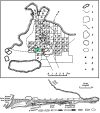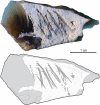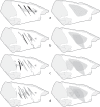Assessing the significance of Palaeolithic engraved cortexes. A case study from the Mousterian site of Kiik-Koba, Crimea - PubMed (original) (raw)
Assessing the significance of Palaeolithic engraved cortexes. A case study from the Mousterian site of Kiik-Koba, Crimea
Ana Majkić et al. PLoS One. 2018.
Abstract
Twenty-Seven Lower and Middle Paleolithic sites from Europe and the Middle East are reported in the literature to have yielded incised stones. At eleven of these sites incisions are present on flint cortexes. Even when it is possible to demonstrate that the engravings are ancient and human made, it is often difficult to distinguish incisions resulting from functional activities such as butchery or use as a cutting board, from those produced deliberately, and even more difficult to identify the scope of the latter. In this paper we present results of the analysis of an engraved cortical flint flake found at Kiik-Koba, a key Mousterian site from Crimea, and create an interpretative framework to guide the interpretation of incised cortexes. The frame of inference that we propose allows for a reasoned evaluation of the actions playing a role in the marking process and aims at narrowing down the interpretation of the evidence. The object comes from layer IV, the same layer in which a Neanderthal child burial was unearthed, which contains a para-Micoquian industry of Kiik-Koba type dated to between c.35 and 37 cal kyr BP. The microscopic analysis and 3D reconstruction of the grooves on the cortex of this small flint flake, demonstrate that the incisions represent a deliberate engraving made by a skilled craftsman, probably with two different points. The lines are nearly perfectly framed into the cortex, testifying of well controlled motions. This is especially the case considering the small size of the object, which makes this a difficult task. The production of the engraving required excellent neuromotor and volitional control, which implies focused attention. Evaluation of the Kiik-Koba evidence in the light of the proposed interpretative framework supports the view that the engraving was made with a representational intent.
Conflict of interest statement
Competing Interests: The authors have declared that no competing interests exist.
Figures
Fig 1. A framework for assessing the character of the engravings on cortexes.
Fig 2. Location of Kiik-Koba cave, Crimea.
Modified after Fig 1 in [73].
Fig 3. Ground plan and stratigraphy of Kiik-Koba cave.
Top: plan of Kiik-Koba cave indicating the excavated area, the extent of the two main Middle Paleolithic occupations and the square meter in which the engraved cortex described in the present study was recovered. Bottom: stratigraphical profile along the south-west limit of the squares 45–35, 77, and 79 X2. Modified after [122].
Fig 4. The engraved flint flake from Kiik-Koba layer IV.
The arrow indicates the point of impact. Scale = 1 cm.
Fig 5. The engraved flint flake from Kiik-Koba, layer IV.
Photo (top) and tracing (bottom). Engraved lines are indicated by dark-grey areas outlined in black, surface damage by light gray areas, flake scars by gray lines.
Fig 6. Close-up views of selected lines on the Kiik-Koba engraved cortex.
a: from left to right, starting points of lines 9, 1, 2, 6, and 3; b: from left to right, starting points of lines 6, 3 and 4; c: from left to right, middle of the lines 12, 2, 13, 3, 7, and 4. Scales = 1 mm.
Fig 7. Intersection between L9 and L11 and their cross-section.
Top left: intersection between L9 and L11 with location of the sections A-B and B-C; Top right: 3D reconstruction of the intersection; Bottom: sections of the two lines.
Fig 8
Probable chronology of the incisions on the Kiik-Koba cortex (left). Note the areas of the cortex concerned by each new engraving episode indicating intent to fill in the center of the cortex (right).
Fig 9. Systematization of the analysis results of the engraved cortex from Kiik-Koba.
Similar articles
- A decorated raven bone from the Zaskalnaya VI (Kolosovskaya) Neanderthal site, Crimea.
Majkić A, Evans S, Stepanchuk V, Tsvelykh A, d'Errico F. Majkić A, et al. PLoS One. 2017 Mar 29;12(3):e0173435. doi: 10.1371/journal.pone.0173435. eCollection 2017. PLoS One. 2017. PMID: 28355292 Free PMC article. - An Early Instance of Upper Palaeolithic Personal Ornamentation from China: The Freshwater Shell Bead from Shuidonggou 2.
Wei Y, d'Errico F, Vanhaeren M, Li F, Gao X. Wei Y, et al. PLoS One. 2016 May 26;11(5):e0155847. doi: 10.1371/journal.pone.0155847. eCollection 2016. PLoS One. 2016. PMID: 27227330 Free PMC article. - An Upper Palaeolithic engraved human bone associated with ritualistic cannibalism.
Bello SM, Wallduck R, Parfitt SA, Stringer CB. Bello SM, et al. PLoS One. 2017 Aug 9;12(8):e0182127. doi: 10.1371/journal.pone.0182127. eCollection 2017. PLoS One. 2017. PMID: 28792978 Free PMC article. - A critical review of the German Paleolithic hominin record.
Street M, Terberger T, Orschiedt J. Street M, et al. J Hum Evol. 2006 Dec;51(6):551-79. doi: 10.1016/j.jhevol.2006.04.014. Epub 2006 Jul 25. J Hum Evol. 2006. PMID: 17014890 Review. - Hunters of the Ice Age: The biology of Upper Paleolithic people.
Holt BM, Formicola V. Holt BM, et al. Am J Phys Anthropol. 2008;Suppl 47:70-99. doi: 10.1002/ajpa.20950. Am J Phys Anthropol. 2008. PMID: 19003886 Review.
Cited by
- Neural correlates of perceiving and interpreting engraved prehistoric patterns as human production: Effect of archaeological expertise.
Salagnon M, Cremona S, Joliot M, d'Errico F, Mellet E. Salagnon M, et al. PLoS One. 2022 Aug 3;17(8):e0271732. doi: 10.1371/journal.pone.0271732. eCollection 2022. PLoS One. 2022. PMID: 35921273 Free PMC article. - A 51,000-year-old engraved bone reveals Neanderthals' capacity for symbolic behaviour.
Leder D, Hermann R, Hüls M, Russo G, Hoelzmann P, Nielbock R, Böhner U, Lehmann J, Meier M, Schwalb A, Tröller-Reimer A, Koddenberg T, Terberger T. Leder D, et al. Nat Ecol Evol. 2021 Sep;5(9):1273-1282. doi: 10.1038/s41559-021-01487-z. Epub 2021 Jul 5. Nat Ecol Evol. 2021. PMID: 34226702 - Linguistic capacity was present in the Homo sapiens population 135 thousand years ago.
Miyagawa S, DeSalle R, Nóbrega VA, Nitschke R, Okumura M, Tattersall I. Miyagawa S, et al. Front Psychol. 2025 Mar 11;16:1503900. doi: 10.3389/fpsyg.2025.1503900. eCollection 2025. Front Psychol. 2025. PMID: 40134728 Free PMC article.
References
- Mellars P. The Neanderthal Legacy: An Archaeological Perspective from Western Europe. Princeton: Princeton University Press; 1996.
- Mellars P. The Neanderthal Problem Continued. Current Anthropology. 1999;40: 341–364. doi: 10.1086/200024 - DOI
- Mithen S. The prehistory of the mind: a search for the origins of art, science and religion London and New York: Thames and Hudson; 1996.
- Bar-Yosef O. The Upper Paleolithic Revolution. Annual Review of Anthropology. 2002;31: 363–393.
- Stringer C, Gamble C. In Search of the Neanderthals: Solving the Puzzle of Human Origins London: Thames and Hudson; 1993.
Publication types
MeSH terms
LinkOut - more resources
Full Text Sources
Other Literature Sources








